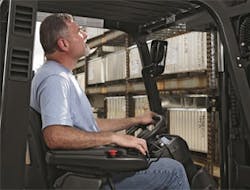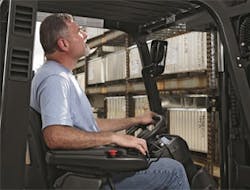Operating a safe, efficient facility begins with forklift operator training that meets Occupational Safety and Health Administration (OSHA) requirements, says Jim Gaskell, director of global Insite products, Crown Equipment (www.crown.com). “Training manuals and videos are helpful assets for presenting information, but nothing replaces actual operating experience,” he says. “Operators learn best through supervised, hands-on practice that allows them to establish best-practice habits and receive supervisor feedback in real-time situations.”
In addition to initial instruction, continued observations and feedback from supervisors help to maintain a safe environment, adds Gaskell. “Safe forklift operation isn’t something that can be practiced once and then neglected,” he explains. “Managers must set the expectation then help employees to demonstrate safe performance on a daily basis.”
All operators should be provided with training to ensure they understand their responsibility in daily safety inspections and have a complete understanding of the control system for the material handling equipment, recommends Michael Keim, material handling business unit leader at Ingersoll Rand (www.ingersollrand.com). “Practical hands-on training and test should be a part of the training process to ensure that the operator demonstrates safe and correct operation,” he says. “While this tends to be common practice for forklift operators, it is often missed for hoist, crane, conveyor, and lift operators.”
All forklift operators must complete a full operator safety training course and site-specific operator training, that is led by a certified operator safety training instructor, says Pat Huebel, national training and customer center operations manager at Toyota Material Handling (www.toyotaforklift.com). “Operators should also be trained on the proper use of hand pallet trucks and dollies,” recommends Huebel. “Safe operational training on these material handling devices are often overlooked, because training on these items isn’t required by law. Moving loads with such devices that are unbalanced or loads that the operator cannot see over, can be dangerous to the operators and pedestrians.”
Pedestrian training also is extremely important when any type of forklift or other material handling equipment is being used in an area where individuals, not operating equipment, are present, explains Huebel. “This training gives pedestrians a better understanding of what operators see and hear and what they don’t see and hear and when equipment or pedestrians have the right of way, while operating equipment or material handling devices.”
Determining the appropriate ratio of automation or technology to real live operators in a material-handling operation depends on many application-specific variables. “You have to consider the activity level,” explains Tim Meyer, Toyota Production System solutions and automatic guided vehicle product manager for Toyota Material Handling USA. “In a low-build-volume customer application, it is 60-70% manual and 30-40% automation, but in another high-volume application, it can be 80% automated and 20% manual,” he offers. “You have to consider, ‘Does it require a lot of human review?’ On average, we’re about a 50/50 society for automation vs. manual. Don’t be fooled by operations where you see a lot of line workers. In most cases they are using some automation within their process. Multi-shift operations with standardized work will tend to incorporate much higher levels of automation.”
Automation can facilitate safety improvements and quality improvements, explains Keim. “This automation comes with a large price tag, so each project needs to be reviewed for financial returns from safety, quality, and productivity improvement, compared to the current process, and weigh that with the project costs and long-term maintenance costs of the new automated equipment,” he suggests.
“There are many variables that need to be evaluated by company’s management team prior to making a decision regarding the use of automation or technology versus the use of material handling operators,” explains Fiala. “Items such as the manufacturing, warehousing, and transportation processes, return on investment, and other company-specific considerations should be thoroughly studied by the company in order to make an informed decision.”
At Crown, the conversation is not around “automation versus operators,” explains Gaskell. “Rather, the focal point of the discussion is around the performance goals of their warehouse and across the supply chain,” he says. “We collaborate with them to gain a clear vision for how their ideal facility will operate and how the forklifts will align with this plan. Each operation is unique, and the only way to truly develop the best solution for integrating new technologies and achieving optimal efficiency is to gather actual performance data to inform decisions. Integrating fleet and operator management technology into an existing or new facility helps managers to be confident that their people and equipment are operating at the highest performance levels.”


